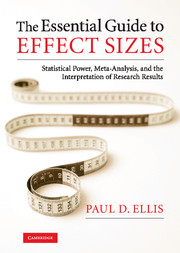 The Essential Guide to Effect Sizes
The Essential Guide to Effect Sizes Book contents
- Frontmatter
- Contents
- List of figures
- List of tables
- List of boxes
- Introduction
- Part I Effect sizes and the interpretation of results
- Part II The analysis of statistical power
- Part III Meta-analysis
- Last word: thirty recommendations for researchers
- Appendices
- 1 Minimum sample sizes
- 2 Alternative methods for meta-analysis
- Bibliography
- Index
2 - Alternative methods for meta-analysis
Published online by Cambridge University Press: 05 June 2012
- Frontmatter
- Contents
- List of figures
- List of tables
- List of boxes
- Introduction
- Part I Effect sizes and the interpretation of results
- Part II The analysis of statistical power
- Part III Meta-analysis
- Last word: thirty recommendations for researchers
- Appendices
- 1 Minimum sample sizes
- 2 Alternative methods for meta-analysis
- Bibliography
- Index
Summary
The two mainstream methods for running a meta-analysis are the methods developed by Hunter and Schmidt (see Hunter and Schmidt 2000; Schmidt and Hunter 1977, 1999) and by Hedges and his colleagues (see Hedges 1981, 1992, 2007; Hedges and Olkin 1980, 1985; Hedges and Vevea 1998). The kryptonite meta-analysis in Chapter 5 was an example of how to apply a stripped-down version of the Hunter and Schmidt method for combining effects reported in the correlational metric (r). In this appendix it will be shown how to meta-analyze both r and d effects using the Hedges et al. method and how to compute mean effect sizes using both fixed- and random-effects procedures. Some comparisons between the methods by Hedges et al. and Hunter and Schmidt will be drawn in the final section.
Combining d effects using Hedges et al.'s method
Let's assume we are interested in the effect of gender on map-reading ability and we have identified ten studies reporting sample sizes (n) and effect sizes (d) as summarized in the first two columns of Table A2.1. The direction of the effect is irrelevant to our meta-analysis and, in the interests of maintaining marital harmony, should probably not receive too much attention anyway – particularly when driving.
Our meta-analysis will generate four outcomes; (1) a mean effect size, (2) a confidence interval for the mean effect size, (3) a z score which can be used to assess the statistical significance of the result, and (4) a Q statistic to quantify the variability in the sample of effect sizes.
Information
- Type
- Chapter
- Information
- The Essential Guide to Effect SizesStatistical Power, Meta-Analysis, and the Interpretation of Research Results, pp. 141 - 152Publisher: Cambridge University PressPrint publication year: 2010